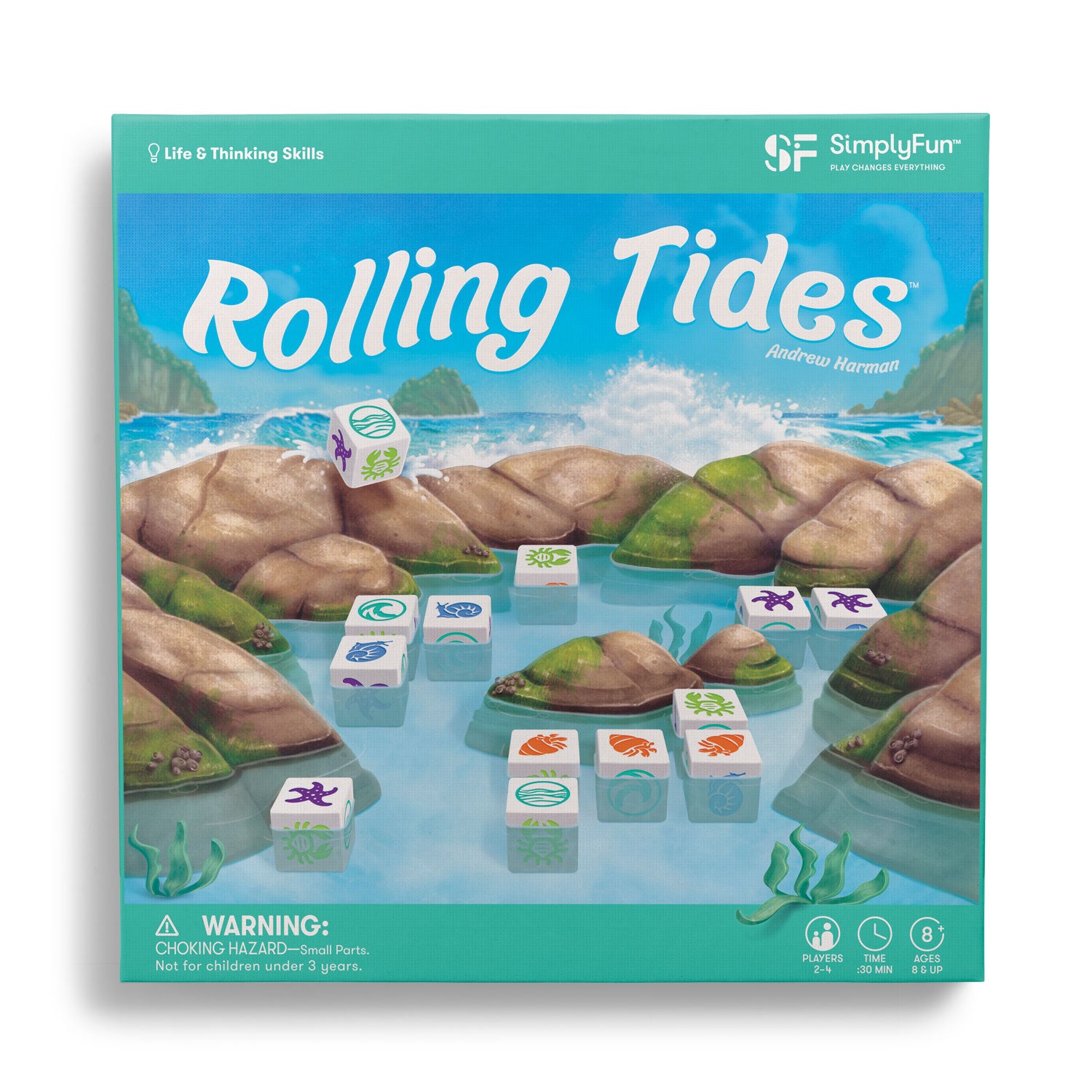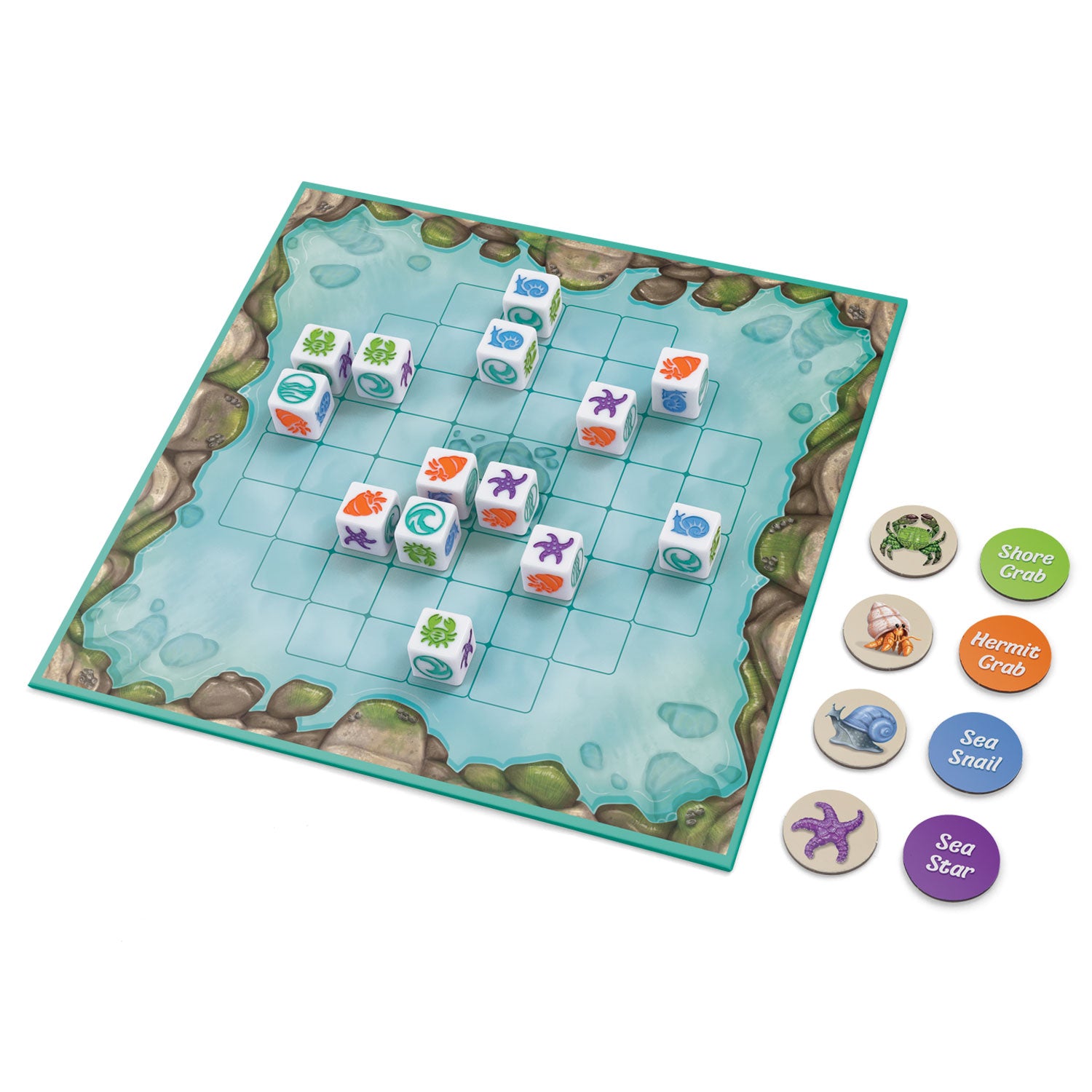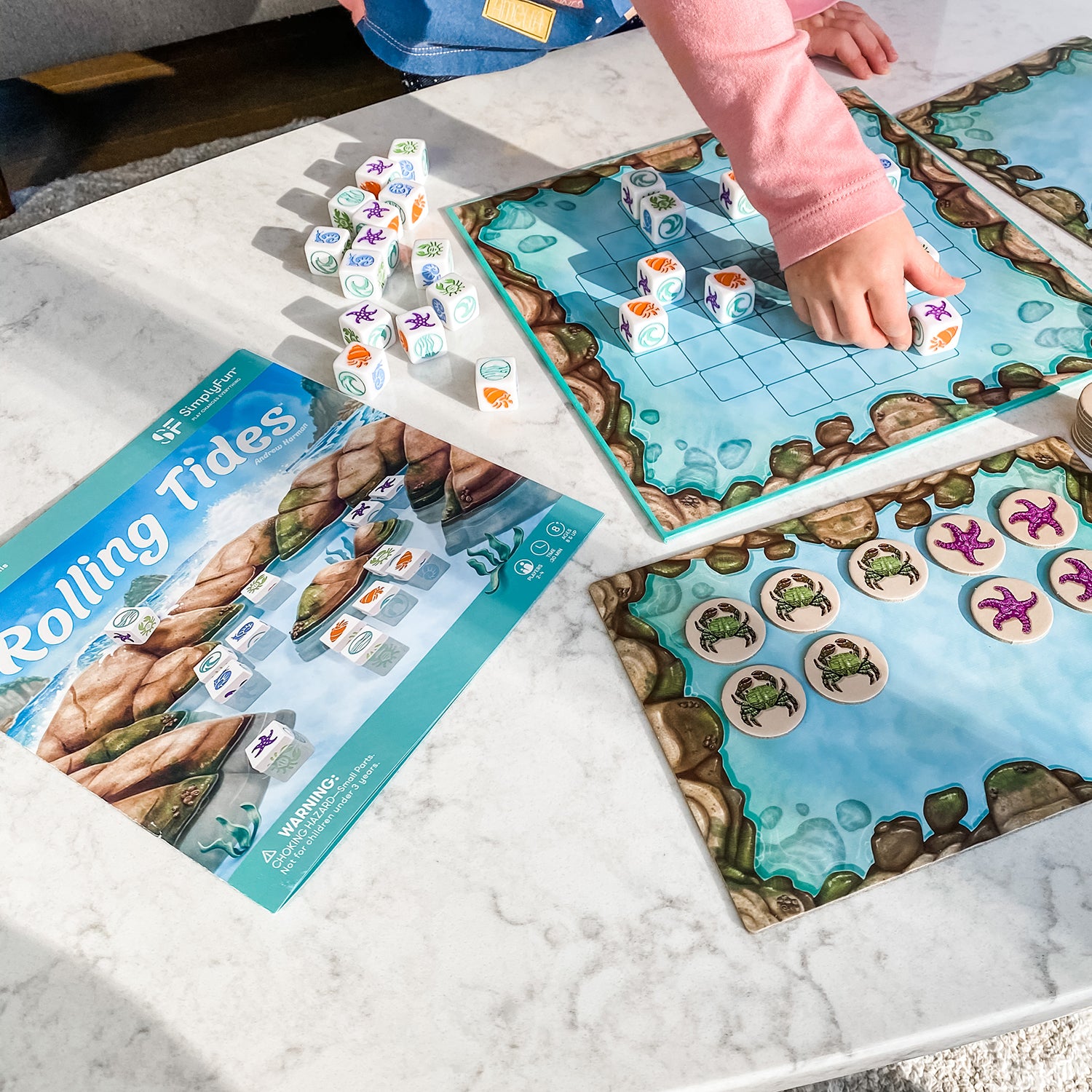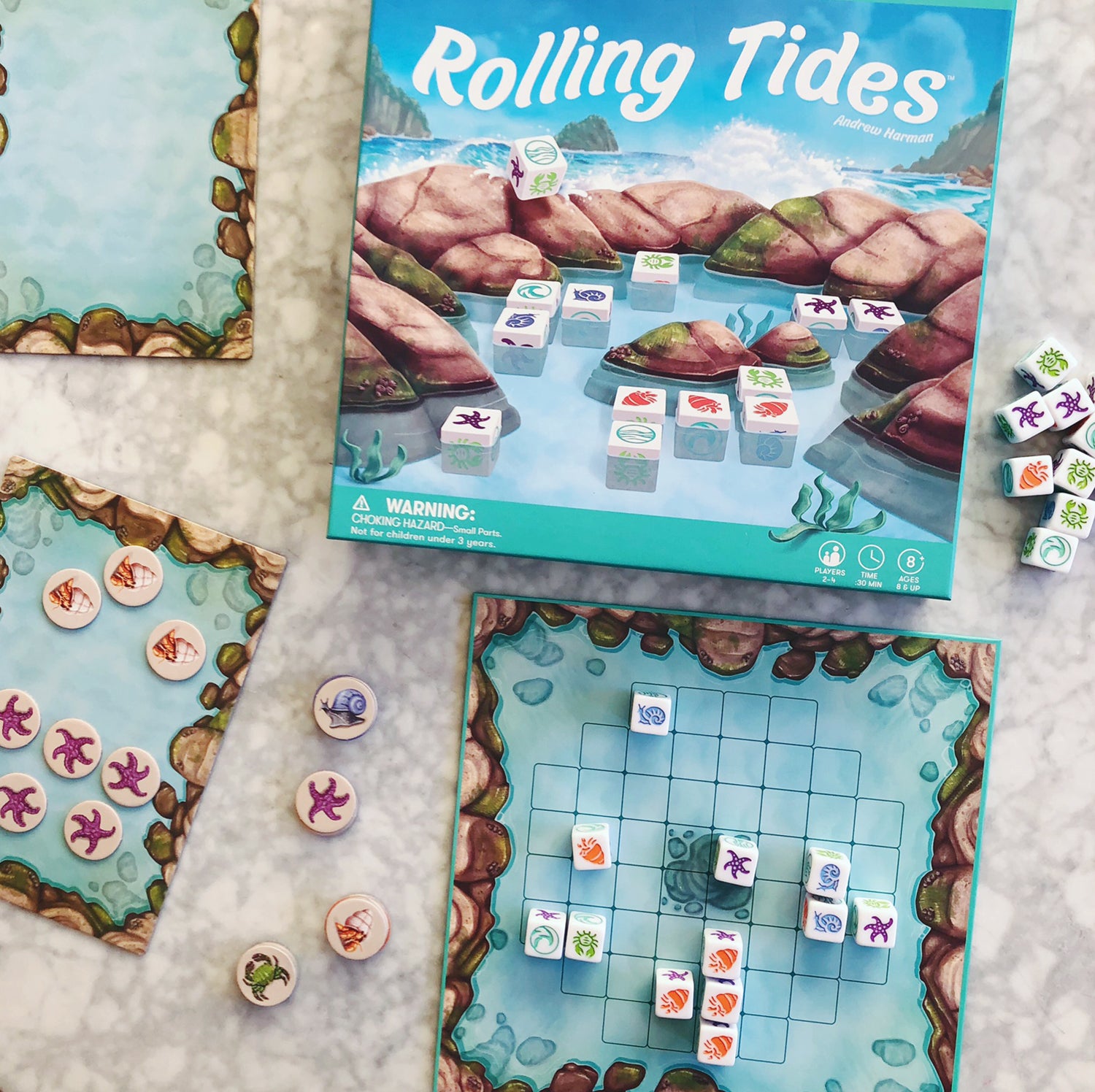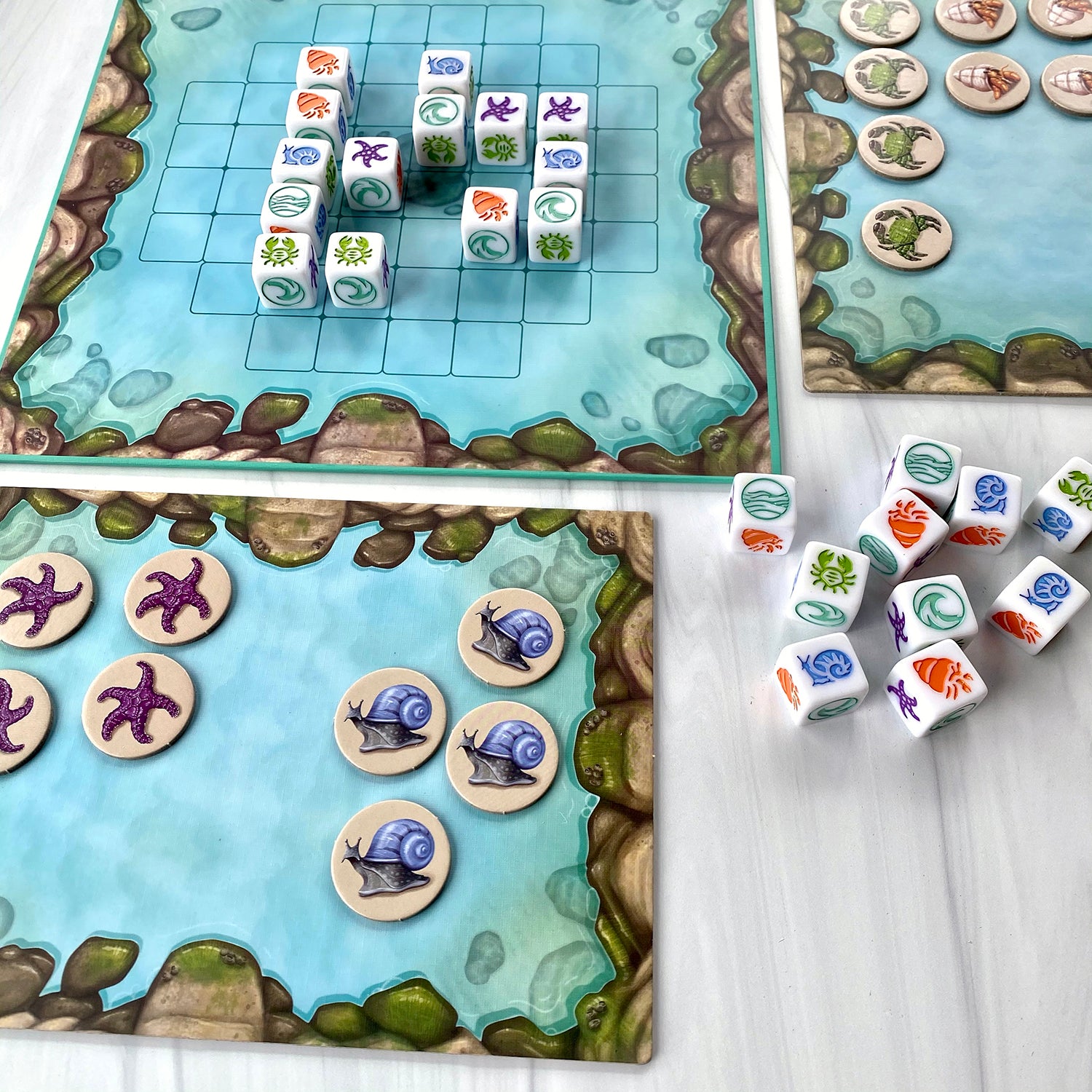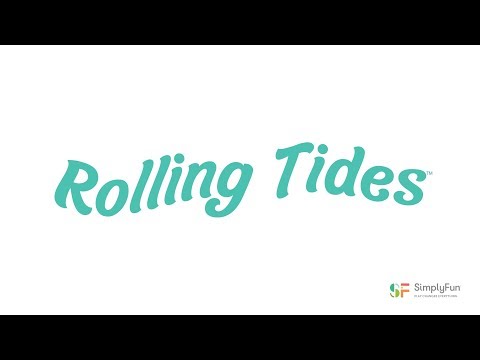Rolling Tides
Rolling Tides
2-4 players • 30 min • 8 & up
Focus: Strategy
Couldn't load pickup availability
Players take turns rolling, moving and placing dice on the gameboard with the goal of creating groups of four or more dice to earn tide-pool animal tokens. The first player to place 20 tokens on their scoreboard wins.
Skills: Decision Making, Spatial Reasoning
Game Includes
Game Includes
- 24 Dice
- 1 Gameboard
- 80 Animal Tokens
- 4 Scoreboards
- 1 Rules Booklet
Share
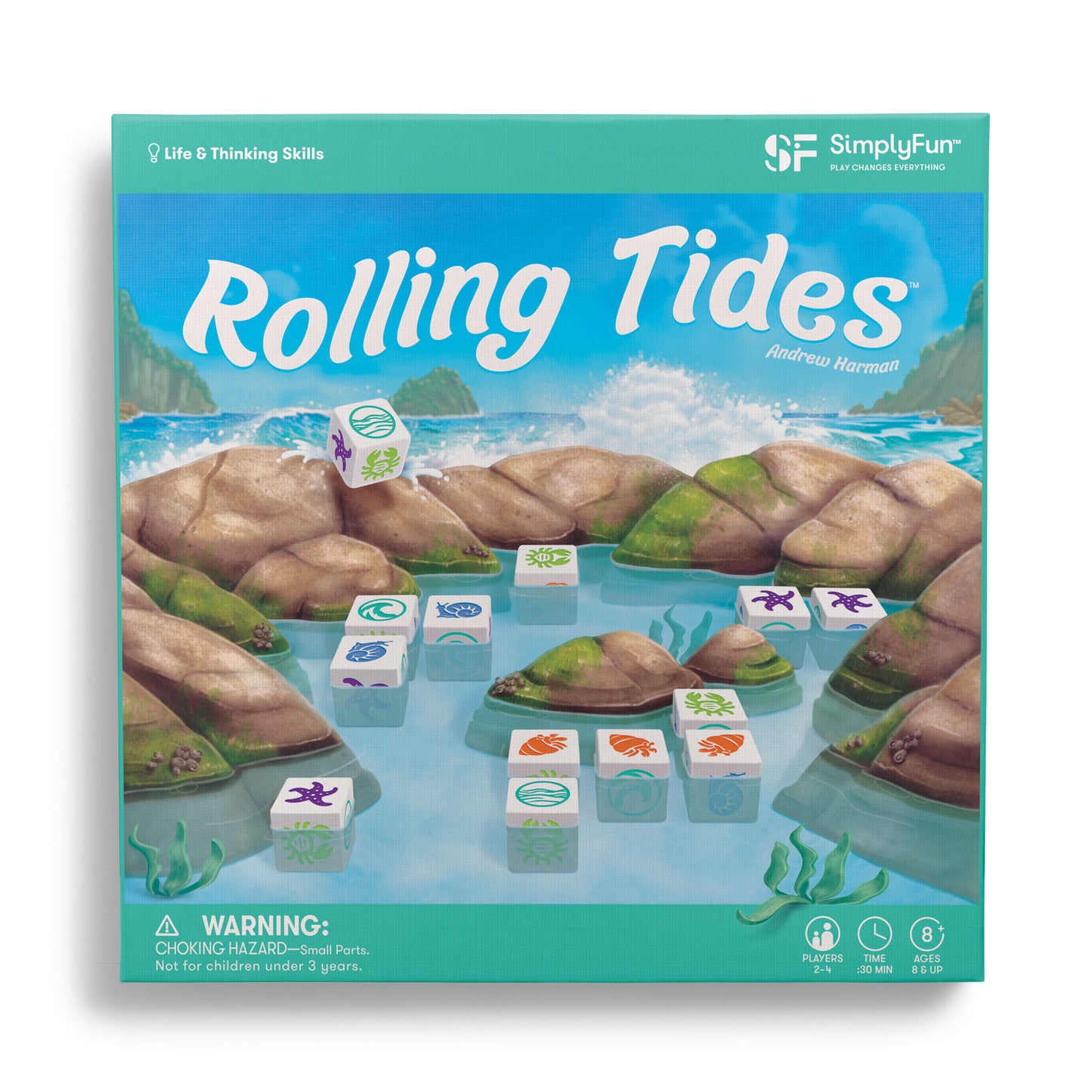
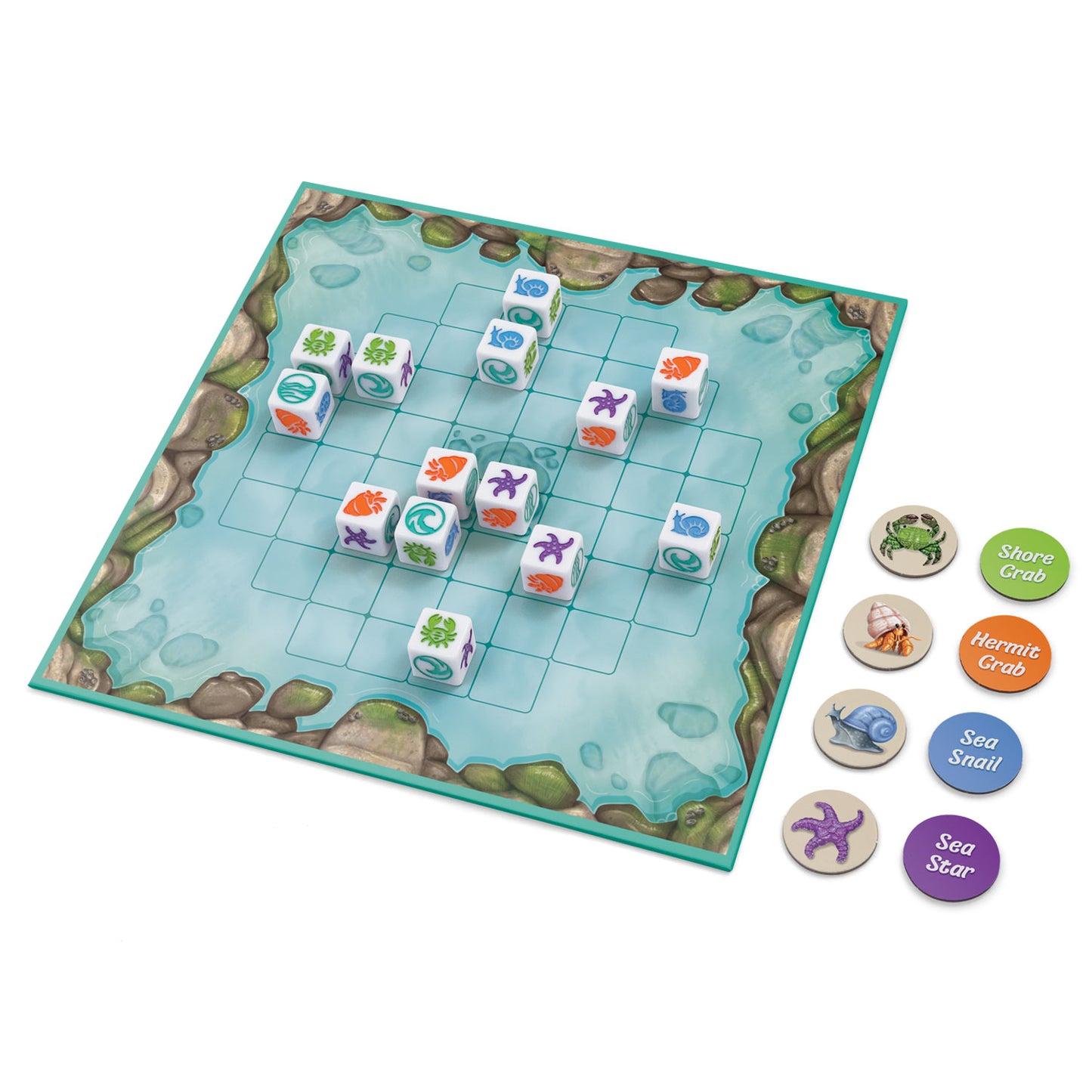
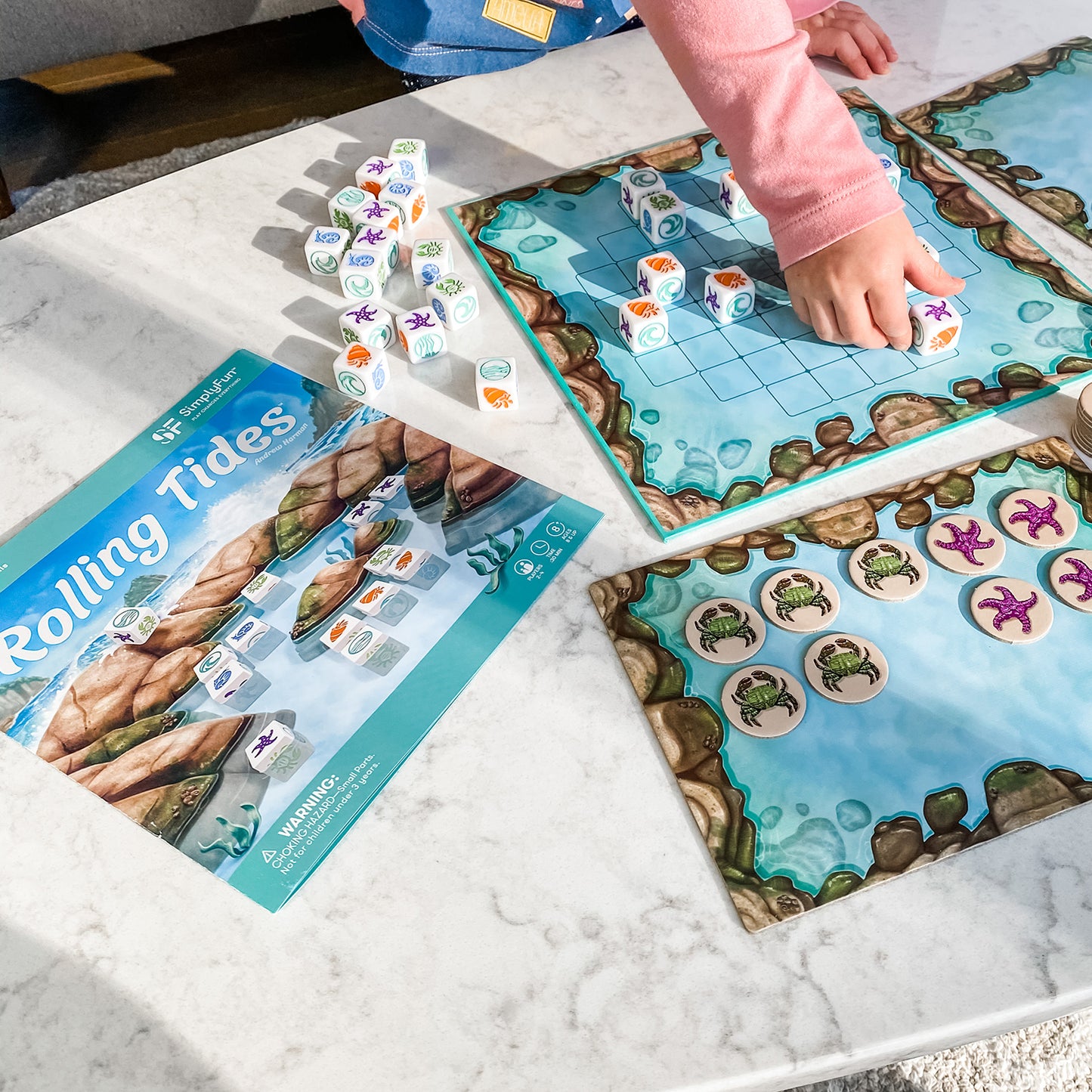
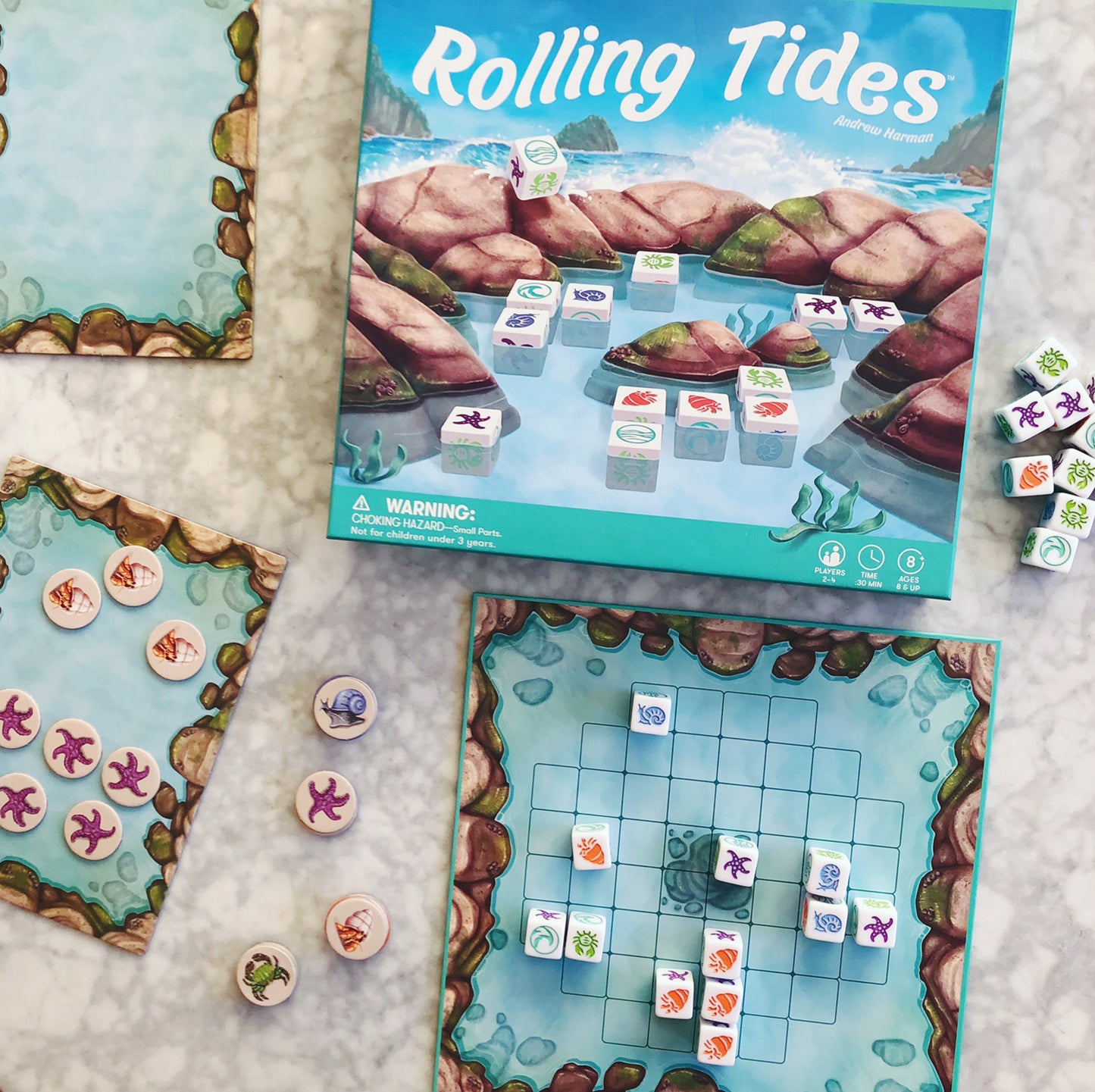
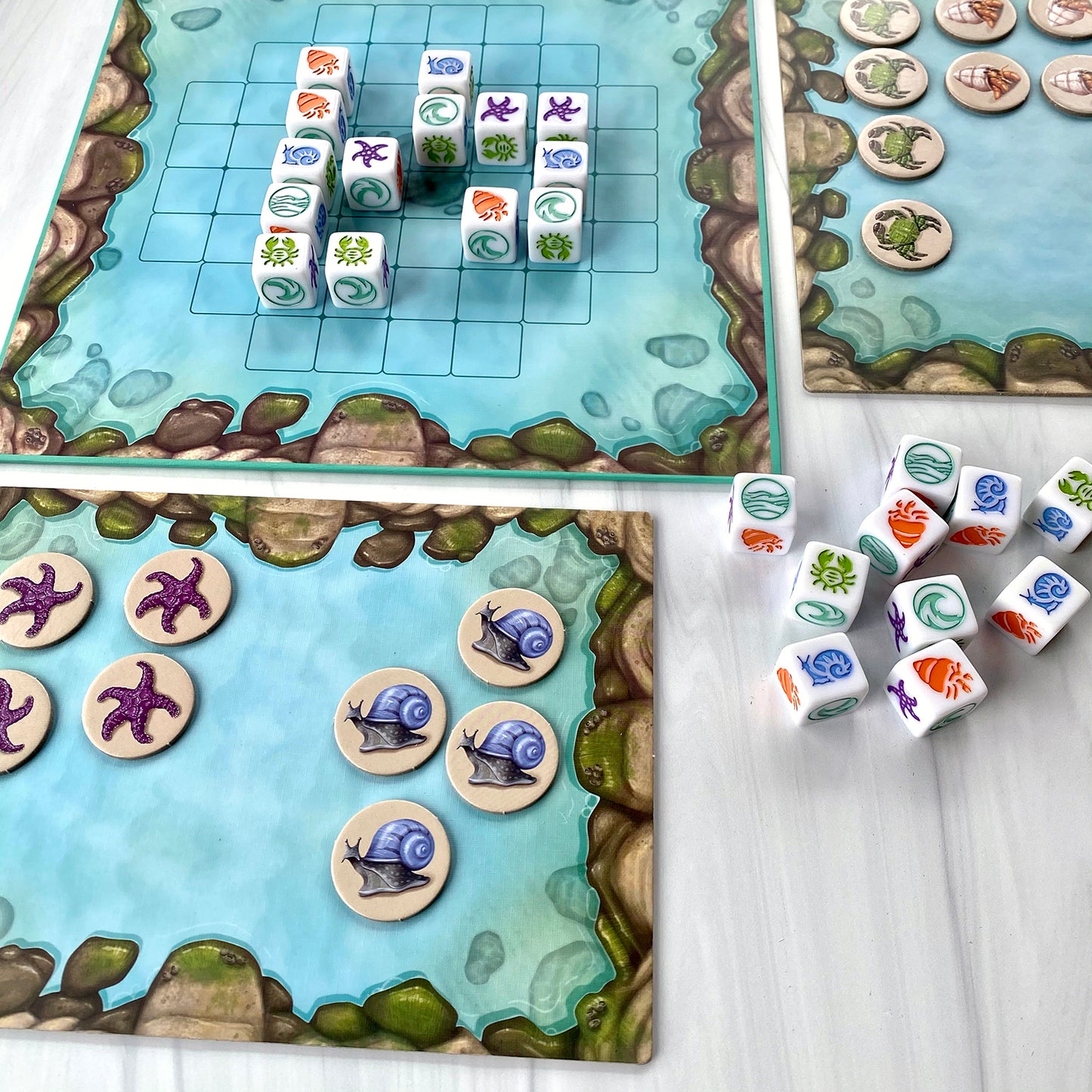

Collapsible content
How to Play
Educational Standards
Core Standard*: Math
Math
- Mathematical Practice
- Make sense of problems and persevere in solving them. Grade Levels 3rd and 4th
Skills
Explore
What Does Child Do To Use Skill In The Game?
Players look for where to move or place dice on the gameboard.
How Parents Can Assist Learning
Encourage children to look closely at where other dice are located, especially where other players may be able to make a grouping of 4 or more of their animal dice. It is important for the child to be able to judge whether to make an offensive or defensive move on their turn.
Learning Implications and Educator Support
Playing Rolling Tides helps children develop spatial reasoning skills, planning and perspective changing.
Encourage children to look closely at where other dice are located, especially where other players may be able to make a grouping of 4 or more of their animal dice. It is important for the child to be able to judge whether to make an offensive or defensive move on their turn.
Determine
What Does Child Do To Use Skill In The Game?
Determining is the primary skill developed playing Rolling Tides as each turn offers players the chance to evaluate different options prior to deciding a specific offensive or defensive move to make.
How Parents Can Assist Learning
Allow children to physically move dice in different directions on the gameboard to evaluate options, prior to deciding on the final move they want to make.
If you notice a child consistently misses the option to move die to a strong offensive or defensive position, ask them to explain their move and then discuss options. This will help the child learn to think carefully and strategically prior to making a final decision.
Learning Implications and Educator Support
In addition to determining where to move one die and place another on a turn, children need to determine what type of strategic approach, offensive or defensive, to use during the game.
Educators can encourage children to discuss their options and to declare whether they want to make an offensive (try to make a group of four or more of an animal set) or defensive (try to block another player from making a group) move prior to placing a piece on the board. Allow children to physically move dice in different directions on the gameboard to evaluate options, prior to deciding on the final move they want to make.
Compare
What Does Child Do To Use Skill In The Game?
Players need to compare symbols (Wave and Current) and animals to make a set. They also need to compare the positions of other players to determine whether to be offensive or defensive on their turn.
How Parents Can Assist Learning
Children will be able to make the comparison of symbols and animals without assistance.
To help with impulsive behavior, encourage children to look closely at the gameboard prior to making a move, including getting up and moving around the table to see the board from different angles. This can help the child see more options and to think carefully before moving.
Learning Implications and Educator Support
Rolling Tides involves a high level of spatial reasoning and strategic thinking. Educators can help children develop these skills by carefully examining the positions of all the dice on the gameboard and to think about what the other players may be trying to achieve.
The educator can help children learn by observing and commenting on why certain moves were good choices. Avoid commenting on bad choices, so as not to embarrass players.
Predict
What Does Child Do To Use Skill In The Game?
Players may try to predict what other players are trying to accomplish based on prior moves.
How Parents Can Assist Learning
Children can increase their ability to predict if they concentrate, compare options and look at the position of all the other dice rather than play impulsively. Help children by asking them to "Wait. Look. Think." Using such cues can give children a model for future play.
In particular, draw children's attention to where other players are starting to create a group of four, making sure to consider that the Current and Wave symbols are wild, i.e. can be any animal. This will help them predict where other players will try to move or place dice on future turns.
Learning Implications and Educator Support
The more players, the harder it become to predict as the gameboard changes multiple times before your turn. Children can increase their ability to predict if they concentrate, compare options, think about how other players have made moves in the past, and look at the position of all the other dice rather than play impulsively. Help children by asking them to "Wait. Look. Think." Using such cues can give children a model for future play.
In particular, draw children's attention to where other players are starting to create a group of four, making sure to consider that the Current and Wave symbols are wild, i.e. can be any animal. This will help them predict where other players will try to move or place dice on future turns.
Plan
What Does Child Do To Use Skill In The Game?
There is a little planning in Rolling Tides as players may try to move dice to avoid being blocked, to get a set of four or more, or block an opponent on their next turn.
How Parents Can Assist Learning
Parents can encourage children to look at options for reaching a goal. Ask questions like "Where are you trying to create your group?" or "Do you think your opponent is trying to create a group or block you?"
Learning Implications and Educator Support
Educators can encourage children to look at options for reaching a goal. Ask questions like "Where are you trying to create your group?" or "Do you think your opponent is trying to create a group or block you?"
Also, Rolling Tides is a good game for helping children develop organizational skills as they plan moves, and adaptive skills as they creatively respond to moves of opponents. Organizing is essential to effective planning and is an important executive functioning skill.
Experiment
What Does Child Do To Use Skill In The Game?
Players will likely experiment with offensive and defensive strategies to determine what is most successful for them in a game or multiple games.
How Parents Can Assist Learning
Discuss different strategies prior to starting the game. When first learning, play a practice game and discuss. Then, play again with the child trying different approaches and strategies (ex: try to block more frequently). Discuss again and compare the advantages and disadvantages. Once children understand different strategies, they can shift and adapt strategies within a game.
Learning Implications and Educator Support
This game involves solving two problems at once. First is how to make a a group of four or more of the same animals, including using wild card dice. Second is how to prevent other's from making a group. Thus, there are different approaches and strategies.
Discuss different strategies prior to starting the game. When first learning, play a practice game and discuss. Then, play again with the child trying different approaches and strategies (ex: try to block more frequently). Discuss again and compare the advantages and disadvantages. Once children understand different strategies, they can shift and adapt strategies within a game.
Further, educators can help children with their strategic thinking by encouraging them to change perspectives, i.e. imagine what an opponent might do. This will help them anticipate which is essential to planning and prediction.
Solve
What Does Child Do To Use Skill In The Game?
Players use their spatial reasoning and adaptability to create groups of four or more animal dice in an effor to be the first person to get 20 tokens.
How Parents Can Assist Learning
After children have mastered the rules and functions of the pieces, they learn new approaches by watching others during game play. This information directly effects how children strategize an approach for placing and moving dice, and ultimately solve the game.
This fundamental ability to shift strategies based on new information is a great life skill that can help children cope with the stresses of change in other areas of their life.
Learning Implications and Educator Support
This game involves uses of visual spatial problem solving, directionality and if/then problem solving. After children have mastered the rules and functions of the pieces, they learn new approaches constantly during game play. This information directly effects how children strategize an approach for placing and moving dice, and ultimately solve the game.
Review
What Does Child Do To Use Skill In The Game?
Players may review their strategies and moves to make improvements going forward as the game progresses.
How Parents Can Assist Learning
This game involves uses of visual spatial problem solving, directionality and if/then problem solving. As the game is being learned, children may move or place dice in non-strategic ways. If parents see this, ask children to explain their thinking and discuss what they might do differently next time.
It is also important for parents to model their own thinking, as this can help children learn a new strategy.
Learning Implications and Educator Support
This game involves uses of visual spatial problem solving, directionality and if/then problem solving. As the game is being learned, children may move or place dice in non-strategic ways. If parents see this, ask children to explain their thinking and discuss what they might do differently next time.
*Data compiled from CCSSI ELA Standards, WA Science Standards, and Washington Social Studies Standards
Special Needs
Cognitive
Suggestions for How to Modify Play Experience
The directions for Rolling Tides are complex. The meaning of the ‘Current’ and ‘Wave’ symbols and the concept of "wild" may be hard for children with cognitive challenges to understand. Blocking another player is also difficult to understand. Eliminate the "wild" dice or use the ‘Current’ and ‘Wave’ dice as two additional sets of symbols to build a group. If they make a group of Current or Wave (example, four Waves), let them take an equal number of their animal tiles.
Change the game of Rolling Tides for children with developmental delays. Make it a matching game. Place one animal die on the edge of each side of the game board. Allow children to roll a die and place it with other similar animals. Count the die in each set as it is grows. Encourage children to visually determine how many dice are in the set. The child can then find a matching animal tiles to place on the scoreboard. When there are 20 animal tiles on a scoreboard, see which scoreboard has the most of any one tile to determine the winner.
Communication
Suggestions for How to Modify Play Experience
Explain the game through demonstration, as the directions may be difficult to understand for children with receptive language difficulties. Language production is not needed while playing the game, but can be encouraged. Ask players to name the animal on the rolled dice, count their animal tiles, discuss potential plays, and so on.
Build vocabulary by reading the information on the back of the score cards and the information about tide pools in the directions. Look for pictures of the animals and other sea creatures in books or online. This will make the game more meaningful.
Sensorimotor
Suggestions for How to Modify Play Experience
If the child lacks motor control for rolling a die softly, use a cup the child can shake and dump out the die.
Placement of the die may be challenging for children with poor fine motor control. It may be helpful to draw a new gameboard with larger squares.
Social Emotional/Behavioral
Suggestions for How to Modify Play Experience
Children with low frustration tolerance may find it difficult to tolerate another player "blocking" their plan to form a group. Have them breathe deeply several times, while helping them to think about their next move and maybe how to block other players as well.
Children with impulsivity may not think carefully about different potential moves. Encourage children to think about more than one option at each turn, so they are looking for other potential groups of animal dice they can build.
Vision
Suggestions for How to Modify Play Experience
Children with low vision may have difficulty seeing the animals on the dice. They can be encouraged to use color matching instead. The green of the shore crab and blues of the current and wave dice may be difficult to discriminate. Other players may need to name what was rolled and remind them of the meaning of the symbol.
Hearing
Suggestions for How to Modify Play Experience
Hearing is not needed to play Rolling Tides. Encourage the player to read the directions as the game is being demonstrated.
*Data compiled from CCSSI ELA Standards, WA Science Standards, and Washington Social Studies Standards
Autism
Autism Strengths & Interests
Short Summary of Strengths & Interests
- Decision making
- Spatial reasoning
- Strategic thinking
Is good at matching visual items
Is This Game Appropriate? Yes
Description
Visual matching is a key element of the game.
Has a good memory for sensory details, including visual, touch, taste and smell
Is This Game Appropriate? No
Description
Memory is not needed to play, but memory for previous strategies is helpful.
Has a good memory for words, phrases and dialouge
Is This Game Appropriate? Yes
Description
Players need to remember rather complex directions, including what to do with the dice that have Current and Wave symbols on them.
Has a good memory for pictures, numbers and patterns
Is This Game Appropriate? Yes
Description
Players need to remember rather complex directions, including what to do with the dice that have Current and Wave symbols on them.
Likes to put things in order or a sequence
Is This Game Appropriate? Yes
Description
Players have to move and order dice to make groups of at least four with contiguous sides.
Learns through visualizing or "replaying" actions in their mind
Is This Game Appropriate? Yes
Description
Players have to visualize the potential location of dice if moved in various directions. They also have to visualize how patterns of dice will change if a die is removed or added. It is also helpful for players to remember or visualize how other players have made a successful move.
Likes activities with rules, such as math and phonics
Is This Game Appropriate? No
Description
Only simple addition is needed in Rolling Tides.
Is very concrete and literal
Is This Game Appropriate? No
Description
The matching aspect of the game is very concrete, but the element of "wild" symbols adds a more abstract element. Also, the Current and Wave symbols cause actions unrelated to the symbols, which is additionally abstract.
Learns in small "chunks" (for example, phone numbers are 3 chunks of number xxx-xxx-xxxx that are combined together)
Is This Game Appropriate? No
Description
Children form groups of four, but memory is not involved.
Is good at nonverbal reasoning and logic
Is This Game Appropriate? Yes
Description
Rolling Tides is a game of nonverbal reasoning, with players determining how to move dice both offensively and defensively to form their own groups and prevent others from forming their own.
Likes spatial problem solving
Is This Game Appropriate? Yes
Description
Rolling Tides is a game of spatial reasoning, with players determining how to move dice both offensively and defensively to form their own groups and prevent others from forming their own.
Can read well with good vocabulary, though may not fully comprehend content
Is This Game Appropriate? Yes
Description
The directions are rather complex, but as long as someone can explain and demonstrate the rules, lack of reading comprehension should not interfere with playing the game.
Likes to use and has good fine motor skill
Is This Game Appropriate? Yes
Description
Players need to roll a die and place die on the board. If the child likes puzzles, Rolling Tides should be a good game.
Likes established routines or set ways of doing things
Is This Game Appropriate? No
Description
Rolling Tides is not predictable, as the dice will be placed differently for each game and game play will vary from one round of play to another. This game is not appropriate
Likes manipulating, constructing or building things
Is This Game Appropriate? No
Description
No building is involved. Players move dice to form groups of four or more.
Likes to use and has good musical abilities
This game is not appropriate
Likes to use and has good drawing skills
This game is not appropriate
Autism Special Considerations
Appears to ignore other's communication and/or has difficulty giving eye contact to a communication partner
Is This Game Appropriate for Child with Characteristic? Yes
Can Child with Characteristic Play Game w/o Modification? Yes
Strategies for Developing Compensatory Skills:
No eye contact is needed for Rolling Tides, as players will watch the manipulation of the dice on the board and the animal tiles on the score board.
Has difficulty understanding complex verbal directions
Is This Game Appropriate for Child with Characteristic? Yes
Can Child with Characteristic Play Game w/o Modification? No
Strategies for Developing Compensatory Skills:
If the child has difficulty comprehending what is read or understanding complex verbal instructions, break down the directions into sections and use the pictures in the instruction book, demonstration, and the video on the SimplyFun website.
Uses vocabulary inaccurately or demonstrates echolalia (repeating another's speech)
Is This Game Appropriate for Child with Characteristic? Yes
Can Child with Characteristic Play Game w/o Modification? Yes
Strategies for Developing Compensatory Skills:
Players will talk about the moves being made on the board. Repetition of what others say should not be a deterrent to play.
Gets stuck repeating a verbal topic or physical actions and/or has difficulty attending to others' actions or topic.
Is This Game Appropriate for Child with Characteristic? No
Can Child with Characteristic Play Game w/o Modification? No
Strategies for Developing Compensatory Skills:
Paying attention to other players' moves is important. Players need to be aware of all their options. Possible moves will change when players use a die to block a move, or as "wild" die are introduced and the board changes.
Has difficulty producing speech/communication
Is This Game Appropriate for Child with Characteristic? Yes
Can Child with Characteristic Play Game w/o Modification? Yes
Strategies for Developing Compensatory Skills:
Speech is not needed to play. Other players can comment on moves produced and provide suggestions or congratulations.
Has difficulty sequencing multi-step actions and/or doing complex abstract tasks
Is This Game Appropriate for Child with Characteristic? Yes
Can Child with Characteristic Play Game w/o Modification? No
Strategies for Developing Compensatory Skills:
There are pictures of tide pool animals on the dice as well as symbols for currents and waves. The latter have abstract meaning as they are "wild" and different moves are implied by the symbol. Although other players can prompt the child with autism what to do, if the child doesn't understand the sequence needed, Rolling Tides may be too frustrating. On the other hand, if prompts are tolerated and responded to well, the game may help the child learn the rules of the over time.
Demonstrates difficulty initiating and maintaining social interactions
Is This Game Appropriate for Child with Characteristic? Yes
Can Child with Characteristic Play Game w/o Modification? Yes
Strategies for Developing Compensatory Skills:
Social interactions are not required to play Rolling Tides, but players will undoubtedly discuss various moves. Encourage other players to engage the child with autism with comments on their play.
Acts out or demonstrates avoidance behaviors when frustrated, overwhelmed, or needs more sensory input.
Is This Game Appropriate for Child with Characteristic? No
Can Child with Characteristic Play Game w/o Modification? No
Strategies for Developing Compensatory Skills:
Children with avoidance or acting out behaviors may be disruptive to the game. Provide fidget toys, short breaks, or a heavy object on the child's lap (deep pressure is calming). If the child is too distracted to maintain attention, Rolling Tides may not be a good match for the child.
Has short attention span for non-preferred activities
Is This Game Appropriate for Child with Characteristic? Yes
Can Child with Characteristic Play Game w/o Modification? No
Strategies for Developing Compensatory Skills:
Many children with autism enjoy puzzles. Explain how the game is like building a puzzle. Attention is needed to play the game. Paying attention to other players' moves is important. Players need to be aware of all their options, and possible moves will change when players use a die to block a move, or as "wild" die are introduced and the board changes.
Needs sameness or consistent routines and/or has difficulty with transitions from one activity to another
Is This Game Appropriate for Child with Characteristic? No
Can Child with Characteristic Play Game w/o Modification? No
Strategies for Developing Compensatory Skills:
Rolling Tides is not predictable, as the dice will be placed differently for each game and game play will vary from one round of play to another. This aspect of Rolling Tides may be frustrating for children who need consistency or routine play.
Has difficulty understanding others' feelings, intentions, and the reasons for others' actions.
Is This Game Appropriate for Child with Characteristic? No
Can Child with Characteristic Play Game w/o Modification? No
Strategies for Developing Compensatory Skills:
Players need to be able to anticipate what other players may do with their die on the board in order to make good decisions about their own moves. They also need to be able to understand why players have made certain moves, so they can learn how to use the strategy
*Data compiled from CCSSI ELA Standards, WA Science Standards, and Washington Social Studies Standards
Extended Play
Extra Ways to Play the Game
Have children do research on the four animals as well as currents, waves, and tide pools. They can then write down their favorite facts. As the game is played, each player who throws a die then names a fact they discovered about the animal or water event.
Materials Needed
Expository books, videos, or internet information about crustaceans, sea creatures, and the ocean.
Developmental Benefits
Children love books with real pictures of animals and ocean life. After reading several books or sections of books with the child, discuss your favorite facts. Sharing informational books is motivating to children and enables discussion that reinforces learning.
Extra Ways to Play the Game
Draw pictures of the different animals in the game and other sea creatures. Share these with others before playing Rolling Tides.
Materials Needed
Paper and markers or crayons.
Developmental Benefits
Creating pictures of the Rolling Tides animals encourages children to notice details, ask questions, and share ideas. Drawing supports imagination and expression of ideas.
Extra Ways to Play the Game
Experiment with new dice moving rules. For example, in one game, dice must be moved 4 spaces. In another, dice can jump over other dice. In another, dice can move diagonally.
Materials Needed
No additional materials needed.
Developmental Benefits
Experimentation helps children learn to be adaptable, resilient and creatively thinkers. It also may make the game more interesting because children are taking control of rule-making.
*Data compiled from CCSSI ELA Standards, WA Science Standards, and Washington Social Studies Standards
Collapsible content
How to Play Video & Transcript
You can play Rolling Tides with 2-4 players, ages 8 and up.
Rolling Tides is great for Decision Making. Players choose which die on the gameboard to move or reroll while trying to create or block groups of matching dice.
Rolling Tides also helps with Spatial Reasoning as players evaluate the gameboard, consider the various dice placement options and then choose where to place the next die.
Place the gameboard in the middle of the play area and set all the dice in a pile near a corner.
Each player chooses a set of tide pool animal tokens and receives a scoreboard.
Each player then places two dice anywhere on the gameboard’s grid with their chosen animal symbol faceup. Next, each player one at a time takes another die and rolls it. They place that die anywhere on the grid, keeping the rolled face showing.
Now you are ready to play.
Players try to group their tide pool animals together by creating groups of four or more dice on the gameboard to earn animal tokens. The first player to place 20 tokens on their scoreboard wins.
The first person to name a sea creature goes first.
On your turn, complete three actions in order—roll a die, move a die and add a die.
Action 1 - Rolling a Die
Start by taking one die from the dice pile and rolling it. Depending on the symbol you roll, try to create a group of your animals or block your opponents from creating their own by doing one of the following:
Action 2 - Moving a Die
If you rolled an animal symbol, select one die on the gameboard that matches that animal and move it three spaces vertically and/or horizontally in any direction.
The movement cannot be diagonal, through another die or forward and back using the same space twice.
If the rolled animal symbol is not on the gameboard, or there is only one matching die that cannot make a valid move, then skip to action 3—Adding a Die.
The current and wave symbols are “wild” and count as any animal.
If you rolled a Current symbol, move any die already on the gameboard three spaces.
If you rolled the Wave symbol, choose any die already on the board and reroll it. Then return it to the same space it came from with the newly rolled face showing.
Action 3 - Adding a Die
Then place the newly rolled die on the board into any empty space.
Play now moves to the next player.
Groups are made up of four or more matching animals.
• A group may include wilds (Current and Wave).
• A group may NOT include two or more other animals. All animals in a group must be the same color.
• The dice forming a group must be touching side by side. Diagonals do not count.
Once you have created a group of four or more of your matching animal symbols (with or without wilds) on your turn, you earn tokens. To score a group, count the number of dice in the group and add that many matching animal tokens to your scoreboard.
Remove the group of dice from the gameboard, and place them back in the dice pile, where everyone can reach them.
NOTE: If there is a group of your animals on the board, you can only score it on your turn.
When playing with fewer than four players, any animal not chosen by a player becomes a “shared animal.” All players may create groups with a shared animal. However, each animal may only be grouped with matching animals. A player cannot mix their chosen animal and a shared animal to make a group.
For example:
**In a three-player game, a player collecting Hermit Crabs was able to score a group with the shared Shore Crab to help reach 20 animal tokens.
**In a two-player game, a player collecting Hermit Crabs was able to score a group with the shared Shore Crab and later, a group with the shared Sea Snail to help reach 20 animal tokens.
The first player to place 20 animal tokens on their scoreboard wins.
Discover and collect the amazing animals found within tide pools as you play Rolling Tides!
- Choosing a selection results in a full page refresh.
- Opens in a new window.

